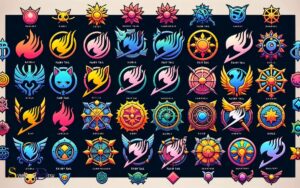Dionysus Roman Name and Symbol: Fertility!
In Roman mythology, Dionysus is known by the name Bacchus and is symbolized by the thyrsus—a staff entwined with ivy and vines. Dionysus, also associated with wine, revelry, and fertility, plays a vital role in both Greek and Roman cultures. His connection to art and ecstasy makes him a companion to Hephaestus and his Roman counterpart, Vulcan, who symbolizes craftsmanship and fire. Together, these gods represent the duality of creative forces in nature, blending chaos and order in artistic expression.
Bacchus is the god of wine, fertility, and ritual madness, often celebrated through festivals and artistic representations.
Bacchus, equivalent to the Greek god Dionysus, is a multifaceted deity whose symbols and attributes reflect his influence over wine, agriculture, and the instinctual nature of humans.
His primary symbol, the thyrsus, is a distinctive staff that signifies both the prosperity of the vine and the unrestrained joy of his devotees.
The worship of Bacchus was marked by theatrical processions and the wild, frenzied celebrations known as Bacchanalia.
Bacchus embodies the spirit of vitality and celebration, with his thyrsus symbolizing life’s boundless pleasures.

Key Takeaway
Origin of Dionysus/Bacchus
The origin of Dionysus, also known as Bacchus in Roman mythology, traces back to ancient Greek religion and mythology. Dionysus was the son of Zeus, the king of the gods, and Semele, a mortal princess.
He was the god of wine, fertility, ritual madness, religious ecstasy, and theater. His worship involved the celebration of wine and the grape harvest, as well as theater and religious festivals.
Dionysus was often depicted as a young, long-haired god with a drinking cup and a crown of ivy, symbolizing his connection to wine and the wild vegetation. His cult spread throughout the Mediterranean, and he became an important figure in the Greek and Roman pantheon.
This rich history laid the foundation for the associations with wine and harvest that became integral to his mythology.
Associations With Wine and Harvest
Dionysus/Bacchus is associated with the cultivation and consumption of wine and the bountiful harvest, playing a significant role in the rituals and celebrations surrounding these agricultural practices.
In Greek mythology, Dionysus is revered as the god of wine, fertility, and religious ecstasy. He is often depicted as a symbol of the grape harvest, winemaking, and the festive enjoyment of wine.
The Dionysian festivals, such as the Anthesteria in Athens, were dedicated to the celebration of the new wine and the arrival of spring.
The god’s association with wine and the harvest also symbolizes the cycle of growth, death, and rebirth, reflecting the agricultural importance of these natural processes.
These associations with wine and harvest have contributed to the enduring cultural significance of Dionysus/Bacchus in ancient and modern societies.
Dionysus/Bacchus in Roman Culture
Having been assimilated into Roman culture, Dionysus/Bacchus became an influential figure in various aspects of Roman society, including religion, art, and festivals, shaping the Roman interpretation of wine, fertility, and religious ecstasy.
In Roman religion, Dionysus was often associated with Liber Pater, a god of fertility and freedom, and was celebrated during the Bacchanalia, wild and mystic festivals in his honor.
The Romans also adopted the Greek art forms and iconography related to Dionysus, incorporating them into their own artistic expressions.
The god’s association with wine and ecstatic rituals influenced Roman attitudes towards these aspects, leading to the widespread use of wine in religious and social contexts.
Dionysus/Bacchus thus played a significant role in shaping Roman culture, leaving a lasting impact on various aspects of Roman life.
Animal Symbolism
In Roman culture, animal symbolism associated with Dionysus/Bacchus emerged during various religious and festive practices. The most prevalent animal symbol linked to Dionysus was the panther, which represented the god’s dual nature—both gentle and fierce.
The spotted skin of the panther also symbolized the starry sky and the connection between the earthly and divine realms.
Additionally, the bull was another significant animal symbol of Dionysus, often depicted in art and mythology. The bull was associated with strength, fertility, and sacrifice, reflecting the god’s attributes and the rituals performed in his honor.
Furthermore, snakes were revered as sacred to Dionysus due to their ability to shed their skin, symbolizing rebirth and renewal.
These animal symbols played a vital role in the worship and understanding of Dionysus’s divine nature and influence.
Dionysian Festivals and Rituals
The celebration of Dionysian festivals and the accompanying rituals played a significant role in ancient Greek and Roman religious practices. These festivals were deeply rooted in the worship of Dionysus and held great cultural and spiritual significance.
Understanding the traditions and rituals associated with these festivals provides valuable insights into the religious and social practices of the time.
Dionysian Festival Traditions
Dionysian festival traditions encompass a rich tapestry of celebrations and rituals dedicated to honoring the god Dionysus. These traditions have been passed down through generations, embodying the spirit of revelry, fertility, and the cycle of life.
Some key elements of Dionysian festival traditions include:
- The Bacchanalia: Wild and ecstatic celebrations involving music, dance, and the consumption of wine.
- Theater performances: The staging of plays and performances, often exploring themes of transformation and liberation.
- Processions and parades: Colorful and lively processions through the streets, accompanied by music and dancing.
- Ritualistic offerings: Devotional acts such as pouring of wine, the burning of incense, and the presentation of symbolic gifts to honor Dionysus.
These traditions offer a glimpse into the vibrant and complex tapestry of ancient religious practices dedicated to the worship of Dionysus.
Ritual Significance in Worship
Ritual significance in worship during Dionysian festivals and rituals is emphasized through the symbolic acts and ceremonies that honor the god Dionysus. Dionysian festivals, such as the Dionysia and the Lenaia, involved elaborate rituals to honor the god.
These rituals included processions, dramatic performances, and animal sacrifices. The Dionysian Mysteries, a secretive and sacred ritual, involved initiates partaking in rites that symbolized the god’s death and rebirth, emphasizing themes of fertility and the cycle of life.
Wine, a symbol of Dionysus, was often central to these rituals, representing the god’s dual nature as both a bringer of ecstasy and a symbol of the earth’s fertility.
The ritual significance in worship during Dionysian festivals and rituals served to connect participants with the divine and celebrate the cyclical nature of life.
Artistic Depictions and Iconography
Frequently depicted in ancient art and iconography, the figure of Dionysus is often portrayed with symbols such as the thyrsus and the grapevine.
These artistic representations offer insight into the mythological significance of Dionysus and his role in ancient culture:
- The thyrsus, a staff topped with a pine cone, symbolizes fertility, prosperity, and the wild nature associated with the god.
- Grapevines and clusters of grapes are commonly featured, representing wine, ecstasy, and the cultivation of the vine, all central to Dionysian worship.
- Panthers and other wild animals frequently accompany Dionysus, highlighting his close connection to untamed natural forces.
- The god is often depicted in a state of revelry, surrounded by maenads and satyrs, capturing the ecstatic and chaotic aspects of his cult.
These images provide a rich visual tapestry that reflects the multifaceted nature of Dionysus. This diverse iconography influenced various art forms, including theater and literature, as the god’s complex character and myths inspired creative expression.
Influence on Theater and Literature
The artistic depictions and iconography of Dionysus have had a profound influence on theater and literature, shaping the portrayal of the god’s complex character and myths in creative works throughout history.
In ancient Greek theater, Dionysus was a central figure, and his myths and symbols were frequently incorporated into tragedies and comedies.
Playwrights such as Euripides and Aristophanes drew inspiration from Dionysian themes, exploring the god’s dual nature as both a source of ecstasy and a bringer of madness.
Additionally, Dionysus’ association with wine, fertility, and the wild provided rich material for poets and authors in their exploration of human nature, desire, and the conflict between civilization and primal instincts.
Even in modern times, the influence of Dionysus can be seen in various literary and theatrical works, demonstrating the enduring impact of this enigmatic deity.
Modern Interpretations and Relevance
Modern interpretations of Dionysus and his relevance in today’s society are multifaceted. From his presence in popular culture to his influence on modern art, the god continues to captivate and inspire.
Understanding how Dionysus resonates in contemporary society sheds light on the enduring significance of his symbolism and mythology.
Dionysus in Pop Culture
Exploring Dionysus’s presence in contemporary culture reveals his enduring influence on modern art, literature, and entertainment. This ancient god continues to captivate and inspire modern audiences through various forms of media.
Some notable examples of Dionysus in pop culture include:
- Literature: Numerous contemporary novels and poems draw inspiration from Dionysian themes, exploring the wild and untamed aspects of human nature.
- Film and Television: Dionysus and his symbols frequently appear in movies and TV shows, often representing themes of ecstasy, freedom, and rebellion.
- Music: Many musicians and songwriters incorporate Dionysian imagery and concepts into their lyrics and performances, celebrating the uninhibited and hedonistic aspects of life.
- Art and Fashion: Dionysus’s influence can be seen in avant-garde art movements and daring fashion designs that embrace the chaotic and ecstatic elements of his mythology.
Influence on Modern Art
With its enduring influence on modern art, Dionysus’s mythology continues to inspire contemporary artists to explore themes of ecstasy, rebellion, and uninhibited expression.
The ancient god’s association with wine, fertility, and wild revelry has been reimagined in diverse art forms.
From paintings and sculptures to performance art and digital media, Dionysus’s influence is evident in the exploration of human desires, the celebration of the senses, and the embrace of chaotic creativity.
Artists often draw on Dionysian elements to challenge societal norms, unleash primal instincts, and delve into the complexities of human nature.
The god’s symbolism as a liberator and a catalyst for transformation resonates with modern audiences, offering a lens through which to examine contemporary issues and express the unbridled spirit of artistic creation.
Relevance in Today’s Society
In contemporary society, artists and scholars continue to draw upon Dionysus’s mythology and symbolism to explore themes of liberation, transformation, and uninhibited expression.
This ancient deity remains relevant in various ways, including:
- Inspiring modern theatrical performances that delve into the complexities of human nature.
- Serving as a symbol of the pursuit of individual freedom and breaking societal norms.
- Influencing the creation of contemporary art that embraces spontaneity and emotional intensity.
- Offering a source of inspiration for the exploration of gender fluidity and the celebration of diverse identities.
Dionysus’s enduring relevance in today’s society speaks to the timeless nature of the themes and concepts associated with this enigmatic figure, demonstrating the enduring power of mythology to inform and inspire modern interpretations and expressions.
Conclusion
The enigmatic entity of Dionysus, known as Bacchus in Roman culture, is associated with wine, harvest, and wild revelry.
The animal symbolism, artistic depictions, and influence on theater and literature showcase the enduring impact of this deity.
The Dionysian festivals and rituals continue to inspire modern interpretations, highlighting the timeless relevance of this captivating figure.






